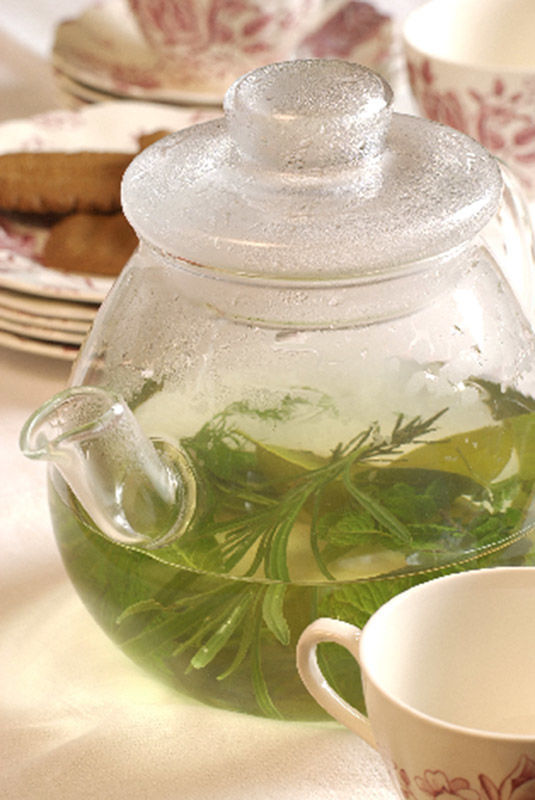
My first experience with herbal tea was an attempt to locate herbs for an allegedly healthful tea an herbalist friend had prescribed. It was about 20 years ago, and the herbs I needed were not easy to find. I remember going to a small health food shop on a side street in Denver. There was an entire room filled with hundreds of large jars, like something you’d imagine might hold eye of newt and other ingredients for potions. The strange aromas were overwhelming, and the names were like a foreign language. As it turned out, the tea I concocted from this adventure was thoroughly vile. Despite my less-than-pleasurable initial experience, it was in that very shop, with all the magical and mysterious sights and smells, that I fell in love with herbs and subsequently, herbal teas.
Infusions vs. Decoctions
There are essentially two ways to prepare herbal tea. An infusion is the best technique for brewing teas when leaves or flowers are used, as they easily release their essential oils and valuable nutrients while steeping in hot water. You simply pour boiling water over loose herbs, cover the pot, and allow the herbs to steep anywhere from 10 to 30 minutes. The tea becomes darker and stronger the longer you steep the herbs. The approximate proportions are 1 teaspoon of dried or 2 teaspoons of fresh herbs to 1 cup of water (or 1 ounce of dry or fresh herbs to 1 quart of water).
Making a decoction is the best method for brewing teas from crushed berries, seeds, roots, bark, and the woody stems of herbs. In this case, the plant material must be simmered in boiling water for 20 to 60 minutes to release its valuable properties. The longer it simmers the stronger it will be. If you’re using a combination of leaves and roots, simmer the roots approximately 20 minutes in a covered container, then remove the pot from the heat. Add the leaves, stir well, cover, and steep 10 to 20 minutes more. Strain both infusions and decoctions before serving.

fresh is best, but dried herbs work too
Using fresh herbs for tea is always preferable because they have a higher nutritive value, flavor, and color. However, fresh herbs don’t last long once picked and are seasonal in many areas, so the best of all worlds is to grow your own herbs and dry them for year-round pleasure.
Whether harvesting for tea or almost any other purpose, you should harvest herbs on a dry, sunny morning, after the dew has evaporated, but before the sun is hot enough to dry the volatile oils from the plants. Don’t pick herbs when they are wet if you’re planning to dry them, since they may become moldy. Use scissors to harvest stems from the plant to get a clean break rather than picking with your fingers, which could pull up the roots. For aromatic leafy herbs, such as mint, the best time to harvest is just before the plant flowers, as this is when the greatest amount of natural oils is concentrated in the leaves. Flowers should be harvested when they are most lovely and fragrant, which is usually when they have just opened. Seeds should be collected when they are barely ripe. Be sure to keep each herb separate and well identified because they often look very similar once they are dry.
Drying is the best method of preserving most herbs and is the best for herbs to be used in tea. The most important thing about drying herbs is to process them as quickly as possible after picking. Once gathered, shake them gently to remove dust and insects. For a quick drying method, spread the herbs on a mesh rack and place them in a warm oven (100˚ to 125˚F). Using a higher heat will destroy the volatile oils. Leave the oven door open and stand by to monitor the herbs. Some leaves dry very quickly. To air-dry herbs, place them on screens in a well-ventilated, warm area, out of direct light and out of insect or rodent range. You may also hang the herbs in bunches, but take care not to make the bunches too large, or the leaves could mold.

Fresh herbs make stronger, more flavorful teas. Here the author holds some of her favorites: violet, mint, borage, lemon verbena, and lemon geranium, collected from her garden.
Large-leafed herbs like mint and sage dry better when picked from their stems. Hang small-leafed herbs like thyme in bunches. Once they’re dry, strip the leaves from the stems by running your fingers down the stem from top to bottom. The herbs are dry if the leaves are crisp and break cleanly. If they bend or are still flexible, they need more drying time.
Store herbs immediately after drying in airtight glass or metal containers. Place them in a cool, dark location, and don’t forget to date and label the container. Properly stored, dried herbs may last one to two years, but are best used within a year.
Freezing works well to preserve some herbs. Lemon balm, lemon verbena, mint, and rosemary can be frozen. Wash the herbs well, pat them dry with towels, and freeze them either whole or chopped. Plastic bags work well, as they take up little space when stacked flat.
Some favorite herbs for tea
Don’t know where to start? Here are some herbs that are easy to grow and will provide you with a good selection of flavors for making tea.
Borage: With its wonderful crisp, cucumber flavor, borage (Borago officinalis) is a “feel good” herb. Either leaves or flowers, harvested just as the plant begins to flower, may be used. Borage is often said to add a “cool” taste to beverages. It does not dry or freeze well.

Use the leaves or flowers of borage to add a “cool” taste to herbal tea. Borage has a clean, crisp cucumber flavor.
Chamomile: Both Roman chamomile (Anthemis nobilis) and German chamomile (Matricaria recutita) produce a delightful, applelike odor when trod upon in the garden and the same refreshing aroma and taste in tea. With moderate sedative and calming effects, chamomile has been called the “doctor for plants,” as it seems to promote healthy growth of all nearby plants. The flowers are used to make tea, but the pollen might cause a reaction for those allergic to ragweed.
Hops: Hops (Humulus lupulus) have been used since the 14th century, chiefly to brew beer, but as a tea herb hops may be used to relax, calm the mind, and encourage sleep. This vigorous perennial vine will need to be trained on a sturdy trellis or fence. Beware, the taste of hops alone is pungent and bitter. Hops are best blended with something more palatable like peppermint. Use the flowers and leaves for tea, but be careful because the flowers’ pollen may cause contact dermatitis.
Lemon balm: The botanical name for lemon balm, Melissa officinalis, is derived from the Greek and refers to the honeybee, the insect that favors this plant. It is a member of the mint family, and is called the “elixir of life” because it is thought to restore youth. Lemon balm is used to calm and to relieve headaches. Fresh or dried, the leaves provide a wonderful lemony taste. Lemon balm is not nearly as invasive as other members of the mint family and is one of the most cooling and refreshing of the tea herbs.
Lemon verbena: One of my favorite tea herbs, lemon verbena (Lippia citriodora, syn. Aloysia triphylla), is a tender perennial native to South America. Historically, water infused with lemon verbena was used in finger bowls at banquets. The leaves have a delightfully sweet lemon taste and scent and are purported to have calming and digestive properties.
Mint: Distinctive, refreshing aromas and tastes characterize the entire Mentha genus. Mint is valued in all parts of the world for tea, cooking, and healing. Apple mint (M. suaveolens), spearmint (M. spicata) and peppermint (M. piperita) are all considered soothing to the digestive system. Many mints can grow aggressively and overrun the garden, so they are best confined to containers. Never boil mint leaves, as it destroys the volatile oil.
Rose hips and petals: There are more than 10,000 varieties of roses (Rosa spp.), the flower of love. A cup of rose hips gathered from old garden roses is said to contain as much vitamin C as 150 oranges. The hips, which should be bruised before infusing, are fruity, aromatic, sour, and pleasant tasting. Rose petals are delicate, exotic, fragrant, and make a tea that is like sipping a cupful of flowers. Be sure to use only organic petals and hips, as roses are often heavily sprayed.
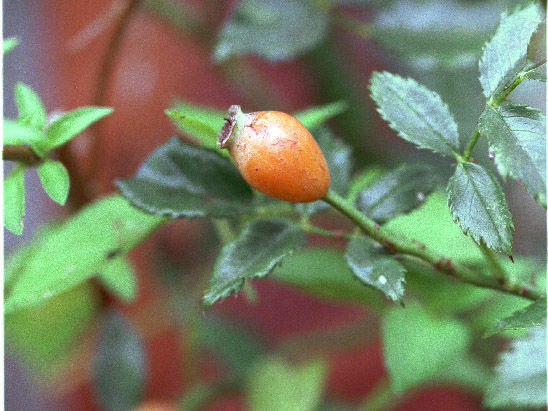
Old garden roses produce fruits called rose hips that can be used to give tea a fruity, somewhat sour taste. Bruise the hips before infusing them in hot water.
Rosemary: Legend has it that rosemary flowers were white until the Virgin Mary hung her blue cloak over a rosemary (Rosmarinus officinalis) bush. From that time on they were blue. A symbol of friendship and remembrance, this evergreen shrub is claimed to be a good natural antioxidant, stimulating circulation and brain function. It contains salicin, a natural glycoside from which aspirin is made. Both the leaves and the flowers are used for tea, producing a piney, aromatic flavor.
Sage: Sage (Salvia officinalis), another member of the mint family, comes from the Latin word salare, meaning “to cure.” Sage is thought to slow aging and enhance memory. An ancient Latin proverb asks, “How can a man die when sages grow in his garden?” Leaves and flowers are used to produce an aromatic, calming tea with a faintly bitter, camphorlike flavor.
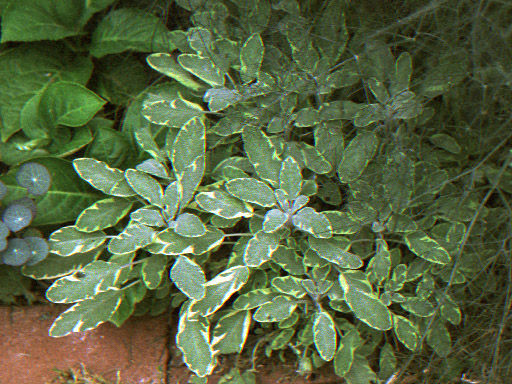
Sage leaves and flowers give an aromatic fragrance but faintly bitter taste to tea.
Violet: Traditionally worn by Greeks to keep anger at bay, violets (Viola odorata) have also been worn as a garland to prevent headaches and dizziness. Perhaps this is because violets contain methyl salicylate, an aspirinlike compound. The flower and leaves used for tea contain an abundance of vitamins A and C, and taste something like wintergreen.
Recipes
These are two of my favorite all-purpose tea blends; both are revitalizing, calming, and delicious. Allow 1 tsp. dried or 2 tsp. fresh herbs per cup of water when making these teas.
Peace on Earth
This blend is perfect for any time you need
an “attitude adjustment.” Infuse the herbs
for 15 minutes, strain, and drink hot.
3 parts skullcap leaves (or substitute lemon balm leaves)
2 parts Passiflora (passionflower) leaves
1 part chamomile flowers and leaves
1 part spearmint leaves
Pinch of stevia
Contains an insignificant amount of nutrients
Cool Sun Tea
Cover herbs with water and set in the sun
for several hours. Strain, sweeten with honey or maple syrup, and serve iced. You can also add equal parts fresh apple and pineapple juice to this tea after it’s brewed.
3 parts hibiscus flowers
2 parts rose hips
1 part lemon verbena leaves
1 part orange slices
1⁄10 part cinnamon chips
Contains an insignificant amount of nutrients
Blends are a matter of flavor and preference.
Before you start blending herbs, it’s a good idea to experience how each herb tastes and smells by itself, then experiment with combinations and ratios. To add a sweet flavor, try anise, licorice, stevia, and sweet Cicely. Mint-flavored herbs include catnip, peppermint, spearmint, violet, and wintergreen. For spicy flavors, add allspice, cardamom, cinnamon, coriander, and ginger. Besides licorice itself, other herbs with a licorice flavor are anise and fennel. For citrus flavor, add lemon balm, lemon grass, lemon or orange peel, or lemon verbena. Rose hips and hibiscus add a tart quality, and flowers such as elder, hawthorn, jasmine, lavender, linden, red clover, and roses add a flowery dimension, aroma, and taste. You can blend a few herbs on the spot or, if you find a combination you enjoy, make up a whole jar. —K.B.
Kathleen Brown is the author of Herbal Teas: 101 Nourishing Blends for Daily Health and Vitality (Storey Books). She gardens in Hawthorne, California.

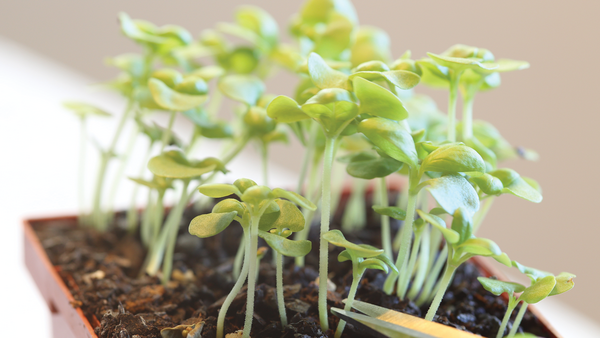


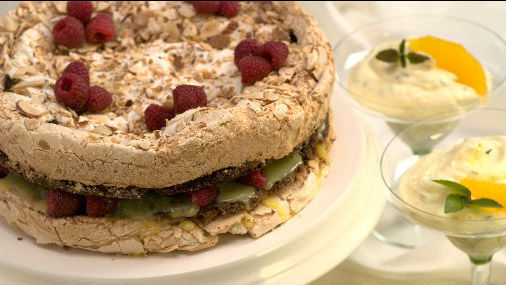












Comments
Thanks for this article, That helps me to learn about the awareness of mesothelioma disease so just from here http://mesotheliomaguide.net/asbestosis learn about the symptoms diagnostic and precaution of mesothelioma disease.
Log in or create an account to post a comment.
Sign up Log in